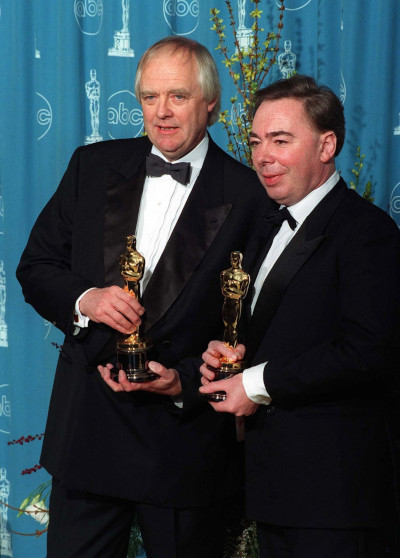50 Years of Jesus Christ Superstar
In the beginning, none of it started on the stage. That’s how it seemed to go for composer Andrew Lloyd Webber and lyricist Tim Rice. The pair began their musical partnership in the 1960s, but it took years for their work to find its way into the avenue that would make them famous: the stage musical. Even Jesus Christ Superstar, which would hit the stage to great success and acclaim in 1971, began life on vinyl as a rock opera concept album. Released 50 years ago this month, Jesus Christ Superstar was the true launch pad for two of the most successful careers in theater. Here’s how a failed Eurovision submission and a new look at the New Testament became a musical classic.
“Any Dream Will Do” from Joseph and the Amazing Technicolor Dreamcoat (Uploaded to YouTube by The Shows Must Go On!)
Webber was born into a family of musicians and was composing his own material by age nine. He studied at the Royal College of Music in the mid 1960s. In 1965, he met Rice, who had a talent for lyrics and would soon be working in the music industry for EMI. The pair collaborated on a musical about the Irish philanthropist Thomas John Barnardo; called The Likes of Us, it wouldn’t be performed in public until 2005. However, the work led to the duo being asked to write a cantata for London’s Colet Court school; the result was a 15-minute, embryonic version of what would become Joseph and the Amazing Technicolor Dreamcoat. Webber and Rice revised and expanded it for years until it got its own release in 1972.

In 1969, Webber and Rice tried to get into the Eurovision Song Contest with an entry titled, appropriately, “Try It and See.” Though the song wasn’t chosen, it would be rewritten and woven into their next big project as “King Herod’s Song.” Rather than put their story straight to the stage, the duo recorded it as a rock opera concept album first. Based loosely on the last few days of the life of Jesus Christ, Jesus Christ Superstar takes its inspiration from the New Testament, but isn’t a literal interpretation. It’s a “sung-through” show, meaning that all of the dialogue is sung, with no breaks for simply spoken passages. The point-of-view character for much of the show is Judas, whose struggles with Christ’s approach to his mission lead to his betrayal of his friend and his eventual suicide.
In the original promo video for the album, Murray Head performs “Superstar” (Uploaded to YouTube by LiveVideoAZ)
To make the album, Webber and Rice brought in a mix of performers from both the U.K. stage and British rock acts. The role of Jesus was filled out by Deep Purple frontman Ian Gillan, while Judas was performed by Murray Head (many Americans know him from the single from the musical Chess, “One Night in Bangkok;” he’s also the brother of Anthony Stewart Head, best-known as Giles from Buffy the Vampire Slayer). Mary Magdalene was brought to life by Yvonne Ellman, who would go on to reprise the role in the film version; Ellman also sang the #1 hit “If I Can’t Have You” from the Saturday Night Fever soundtrack.
The disc began making waves around the world upon its September release, and by 1971, it was selling strong before the musical had even been produced in the States. The show was first performed in the U.S. as a concert in Pittsburgh in July of 1971; Ellman played Mary Magdalene, and Carl Anderson played Judas (as he would in the later film adaptation). The album went to #1 in the U.S. In October, the show opened on Broadway (with Ellman). Though some groups objected to the musical (notably, those that thought that the text wasn’t religious enough, and those that found the Jewish characters to be depicted as more villainous), the show proved to be enduringly popular.
The trailer for the 1973 film Jesus Christ Superstar (Uploaded to YouTube by Movieclips Classi Trailers)
The 1973 film adaption, directed by Norman Jewison, earned Golden Globe nominations for Ellman, Anderson, and Ted Neeley, who played Jesus. An adaptation filmed for television in 1999 won an International Emmy Award for Best Performing Arts Film. More recently, NBC mounted a live concert version on Easter Sunday in 2018; notable cast members included John Legend as Jesus, Brandon Victor Dixon as Judas, Sara Bareilles as Mary Magdalane, and Alice Cooper as King Herod.
Sara Bareilles and Andrew Lloyd Webber perform “I Don’t Know How to Love Him” (Uploaded to YouTube by NBC)
The success of the original musical catapulted Webber and Rice into fame. It allowed them to mount Joseph as a successful production; they reteamed for Evita in 1976 and collaborated on The Wizard of Oz in 2011. On his own and with other collaborators, Webber has had enormous success, including Cats, The Phantom of the Opera, and Sunset Boulevard. Rice has also done extraordinarily well, co-writing Chess with Benny and Bjorn of ABBA, co-writing Aida with Elton John, and providing lyrics for Disney films like Aladdin and The Lion King. Webber and Rice are two of only sixteen people to have an “EGOT,” having won at least one Emmy, Grammy, Oscar, and Tony in their careers.
The ongoing popularity of Jesus Christ Superstar can be attributed to a number of factors. Obviously, its subject matter is based on a major world religion, and one of the most well-known stories on the planet. But Webber and Rice transformed it into incredibly memorable pop tunes, and tried to express the story in more relatable, human terms. It’s that level of connection that sticks with the watcher or the listener, and its why the album, and the show, still retain their power 50 years later.
Featured image: Dutchmen Photography / Shutterstock